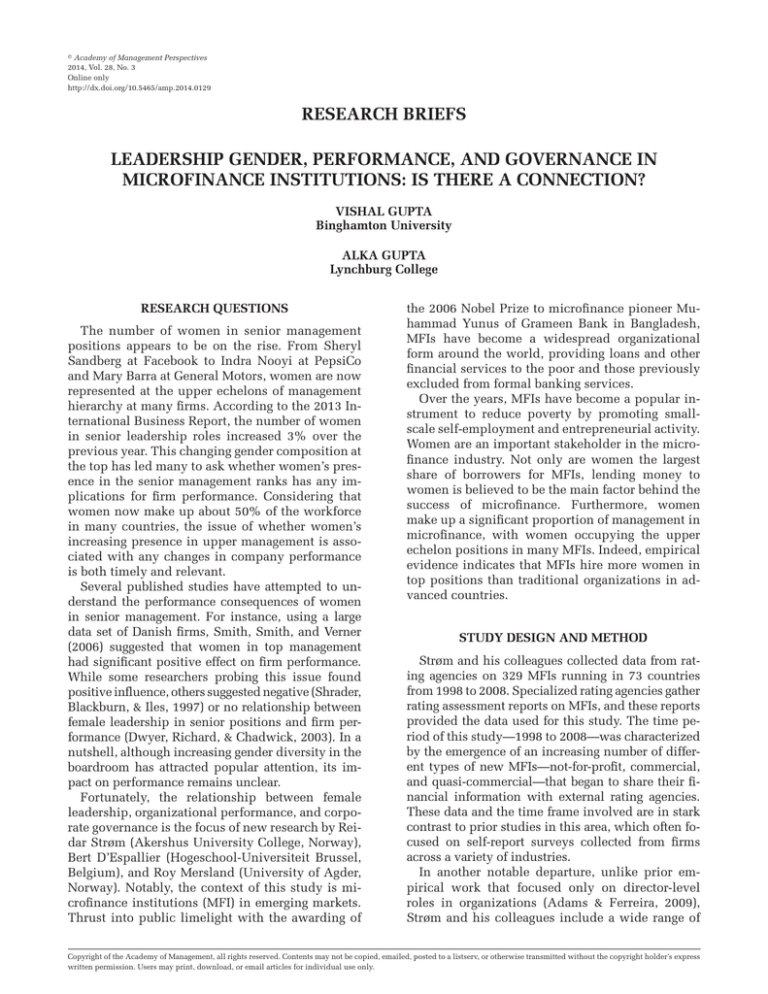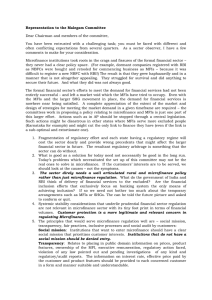RESEARCH BRIEFS LEADERSHIP GENDER, PERFORMANCE, AND GOVERNANCE IN
advertisement

r Academy of Management Perspectives 2014, Vol. 28, No. 3 Online only http://dx.doi.org/10.5465/amp.2014.0129 RESEARCH BRIEFS LEADERSHIP GENDER, PERFORMANCE, AND GOVERNANCE IN MICROFINANCE INSTITUTIONS: IS THERE A CONNECTION? VISHAL GUPTA Binghamton University ALKA GUPTA Lynchburg College RESEARCH QUESTIONS The number of women in senior management positions appears to be on the rise. From Sheryl Sandberg at Facebook to Indra Nooyi at PepsiCo and Mary Barra at General Motors, women are now represented at the upper echelons of management hierarchy at many firms. According to the 2013 International Business Report, the number of women in senior leadership roles increased 3% over the previous year. This changing gender composition at the top has led many to ask whether women’s presence in the senior management ranks has any implications for firm performance. Considering that women now make up about 50% of the workforce in many countries, the issue of whether women’s increasing presence in upper management is associated with any changes in company performance is both timely and relevant. Several published studies have attempted to understand the performance consequences of women in senior management. For instance, using a large data set of Danish firms, Smith, Smith, and Verner (2006) suggested that women in top management had significant positive effect on firm performance. While some researchers probing this issue found positive influence, others suggested negative (Shrader, Blackburn, & Iles, 1997) or no relationship between female leadership in senior positions and firm performance (Dwyer, Richard, & Chadwick, 2003). In a nutshell, although increasing gender diversity in the boardroom has attracted popular attention, its impact on performance remains unclear. Fortunately, the relationship between female leadership, organizational performance, and corporate governance is the focus of new research by Reidar Strøm (Akershus University College, Norway), Bert D’Espallier (Hogeschool-Universiteit Brussel, Belgium), and Roy Mersland (University of Agder, Norway). Notably, the context of this study is microfinance institutions (MFI) in emerging markets. Thrust into public limelight with the awarding of the 2006 Nobel Prize to microfinance pioneer Muhammad Yunus of Grameen Bank in Bangladesh, MFIs have become a widespread organizational form around the world, providing loans and other financial services to the poor and those previously excluded from formal banking services. Over the years, MFIs have become a popular instrument to reduce poverty by promoting smallscale self-employment and entrepreneurial activity. Women are an important stakeholder in the microfinance industry. Not only are women the largest share of borrowers for MFIs, lending money to women is believed to be the main factor behind the success of microfinance. Furthermore, women make up a significant proportion of management in microfinance, with women occupying the upper echelon positions in many MFIs. Indeed, empirical evidence indicates that MFIs hire more women in top positions than traditional organizations in advanced countries. STUDY DESIGN AND METHOD Strøm and his colleagues collected data from rating agencies on 329 MFIs running in 73 countries from 1998 to 2008. Specialized rating agencies gather rating assessment reports on MFIs, and these reports provided the data used for this study. The time period of this study—1998 to 2008—was characterized by the emergence of an increasing number of different types of new MFIs—not-for-profit, commercial, and quasi-commercial—that began to share their financial information with external rating agencies. These data and the time frame involved are in stark contrast to prior studies in this area, which often focused on self-report surveys collected from firms across a variety of industries. In another notable departure, unlike prior empirical work that focused only on director-level roles in organizations (Adams & Ferreira, 2009), Strøm and his colleagues include a wide range of Copyright of the Academy of Management, all rights reserved. Contents may not be copied, emailed, posted to a listserv, or otherwise transmitted without the copyright holder’s express written permission. Users may print, download, or email articles for individual use only. Academy of Management Perspectives leadership positions in their study, including directors, CEOs, and board chairs. In their sample of MFIs, 27% of CEOs, 23% of board chairs, and 29% of directors were women. To assess firm performance, Strøm and his colleagues measured return on assets (ROA), return on equity (ROE), and operational and financial self-sufficiency (OSS and FSS). They operationalized OSS as the ratio of portfolio revenues to operational expenses. For FSS, they accounted for MFI-specific adjustments, including (but not limited to) financial costs, default costs, and subsidies. Another variable, achievement of social mission, was measured through the MFI’s gender bias, its rural bias, and the average loan amount. Together, these performance measures capture the dual objectives of MFIs: to serve the poor and to do so in a financially sustainable way. To assess governance mechanisms, Strøm and his colleagues measured number of board meetings, CEO/Chair duality, presence of internal auditors, and board size. Institutional variables such as the MFI’s regulatory status, its founding status (internationally initiated or not), the competition in its product market, and its ownership type were also measured. KEY FINDINGS The results revealed that female leadership is more prominent in MFIs with majority female clientele. This is consistent with the suggestion that the emergence of female leadership in MFIs is consistent with MFI’s social mission of lending to women. The argument is that women in leadership positions are able to understand the needs and wants of female customers, and tailor their offerings accordingly. In addition, women are increasingly likely to have leadership roles in NGOs and cooperatives, in urban markets, and in younger entrepreneurial firms. Next, Strøm and his colleagues attempted to address whether women in senior positions are significant drivers of firm performance. Consistent with some prior research, the results showed that female CEOs enhance firm performance in MFIs, although, interestingly, having female directors and chairs also had a positive impact on firm performance. In effect, having female CEOs, directors, and chairs is associated with better firm performance in general, supporting the matching argument of leadership and tasks. Consequently, having women in top management improved overall performance at firm level. Finally, Strøm and his colleagues analyzed the nuanced relationship between women in leadership and corporate governance. Interestingly, the positive impact of female leaders on financial August performance was not replicated when it came to corporate governance. Contrary to the idea that having women in leadership roles brings better governance practices (Adams & Ferreira, 2009), the results from MFIs showed quite the opposite. Specifically, having more women in leadership positions in MFIs was associated with weaker governance practices (e.g., fewer board meetings, fewer internal audits, and more CEO duality). Overall, these conflicting results vis-à-vis prior research may stem from the difference in measures of leadership used. Strøm and his colleagues argue that prior studies focused only on the director roles while their MFI sample included leadership at chair, CEO, and director levels—a much broader conceptualization of leadership in the organization. CONCLUSION AND IMPLICATIONS Microfinance is said to be largely a women’s business due to a high percentage of women who both lead and lend to MFIs. Thanks to its origins in experimental development schemes in Asia and Latin America in the 1970s, the microfinance sector remains closely associated with providing access to financial services to poor families and small businesses, situated mostly in developing and newly industrialized countries. A unique feature of MFIs in underdeveloped countries is that they hire more female CEOs and elect more women as chairs and directors than traditional firms do in advanced countries. In this study, Strøm and his colleagues set out to shed light on the relationships between female leadership, corporate governance, and financial performance of MFIs. Strøm and his colleagues draw three main conclusions from their research. First, consistent with matching theory arguments, women are more likely to be in leadership roles when the MFI’s mission is to supply credit, particularly to women. Second, having women in CEO, chair, and director roles tends to strengthen financial performance for MFIs, providing further support for matching theory arguments since microfinance is an industry largely catering to female customers. Third, when women occupy leadership positions, firms have fewer board meetings and internal audits, and chief executives hold dual positions, arguably resulting in weaker corporate governance. Strøm and his colleagues conclude that female leadership is advantageous for microfinance firms. The finding that female-led MFIs have less oversight and lower monitoring is somewhat perplexing. Strøm and his colleagues argue that because microfinance firms are young and entrepreneurial, their governance structure may still be in flux. It Vishal Gupta and Alka Gupta 2014 would be interesting to assess whether women who are in leadership positions in other entrepreneurial contexts are equally, if not more, effective even in the presence of sub-optimal governance mechanisms. performance. Journal of Financial Economics, 94, 291–309. SOURCE Dwyer, S., Richard, O. C., & Chadwick, K. (2003). Gender diversity in management and firm performance: The influence of growth orientation and organizational culture. Journal of Business Research, 56, 1009– 1019. Strøm, R. Ø., D’Espallier, B., & Mersland, R. (2014). Female leadership, performance, and governance in microfinance institutions. Journal of Banking and Finance, 42, 60–75. Shrader, C. B., Blackburn, V. B., & Iles, P. (1997). Women in management and firm financial performance: An exploratory study. Journal of Managerial Issues, 9, 355–73. REFERENCES Adams, R.B., & Ferreira, D. (2009). Women in the boardroom and their impact on governance and Smith, N., Smith, V., & Verner, M. (2006). Do women in top management affect firm performance? A panel study of 2,500 Danish firms. International Journal of Productivity and Performance Management, 55, 569–593.








